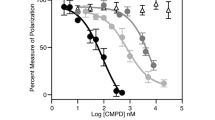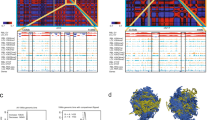Abstract
The Epstein–Barr nuclear antigens (EBNA), EBNA-3, -4 and -6, have previously been shown to act as transcriptional regulators, however, this study identifies another function for these proteins, disruption of the G2/M checkpoint. Lymphoblastoid cell lines (LCLs) treated with a G2/M initiating drug azelaic bishydroxamine (ABHA) did not show a G2/M checkpoint response, but rather they display an increase in cell death, a characteristic of sensitivity to the cytotoxic effects of the drug. Cell cycle analysis demonstrated that the individual expression of EBNA-3, -4 or -6 are capable of disrupting the G2/M checkpoint response induced by ABHA resulting in increased toxicity, whereas EBNA-2, and -5 were not. EBNA-3 gene family protein expression also disrupted the G2/M checkpoint initiated in response to the genotoxin etoposide and the S phase inhibitor hydroxyurea. The G2 arrest in response to these drugs were sensitive to caffeine, suggesting that ATM/ATR signalling in these checkpoint responses may be blocked by the EBNA-3 family proteins. The function of EBNA-3, -4 and -6 proteins appears to be more complex than anticipated and these data suggest a role for these proteins in disrupting the host cell cycle machinery.
This is a preview of subscription content, access via your institution
Access options
Subscribe to this journal
Receive 50 print issues and online access
$259.00 per year
only $5.18 per issue
Buy this article
- Purchase on Springer Link
- Instant access to full article PDF
Prices may be subject to local taxes which are calculated during checkout








Similar content being viewed by others
References
Ben Bassat H, Goldblum N, Mitrani S, Goldblum T, Yoffey JM, Cohen MM, Bentwich Z, Ramot B, Klein E and Klein G . (1977). Int. J. Cancer, 19, 27–33.
Berezutskaya E, Yu B, Morozov A, Raychaudhuri P and Bagchi S . (1997). Cell Growth Differ., 8, 1277–1286.
Blasina A, Price BD, Turenne GA and McGowan CH . (1999). Curr. Biol., 9, 1135–1138.
Brondello JM, Boddy MN, Furnari B and Russell P . (1999). Mol. Cell. Biol., 19, 4262–4269.
Burgess AJ, Pavey S, Warrener R, Hunter LJ, Piva TJ, Musgrove EA, Saunders N, Parsons PG and Gabrielli BG . (2001). Mol. Pharmacol., 60, 828–837.
Cannell EJ, Farrell PJ and Sinclair AJ . (1996). Oncogene, 13, 1413–1421.
Chaturvedi P, Eng WK, Zhu Y, Mattern MR, Mishra R, Hurle MR, Zhang X, Annan RS, Lu Q, Faucette LF, Scott GF, Li X, Carr SA, Johnson RK, Winkler JD and Zhou BB . (1999). Oncogene, 18, 4047–4054.
Chehab NH, Malikzay A, Appel M and Halazonetis TD . (2000). Genes Dev., 14, 278–288.
Cludts I and Farrell PJ . (1998). J. Virol., 72, 1862–1869.
Connell MJ, Walworth NC and Carr AM . (2000). Trends Cell. Biol., 10, 296–303.
Darbon JM, Penary M, Escalas N, Casagrande F, Goubin-Gramatica F, Baudouin C and Ducommun B . (2000). J. Biol. Chem., 275, 15363–15369.
Elledge SJ . (1996). Science, 274, 1664–1672.
Enoch T and Nurse P . (1990). Cell, 60, 665–673.
Floettmann JE, Ward K, Rickinson AB and Rowe M . (1996). Virology, 223, 29–40.
Gabrielli BG, De Souza CP, Tonks ID, Clark JM, Hayward NK and Ellem KA . (1996). J. Cell Sci., 109, 1081–1093.
Goodwin EC and DiMaio D . (2000). Proc. Natl. Acad. Sci. USA, 97, 12513–12518.
Grundhoff AT, Kremmer E, Tureci O, Glieden A, Gindorf C, Atz J, Mueller-Lantzsch N, Schubach WH and Grasser FA . (1999). J. Biol. Chem., 274, 19136–19144.
Hirao A, Kong YY, Matsuoka S, Wakeham A, Ruland J, Yoshida H, Liu D, Elledge SJ and Mak TW . (2000). Science, 287, 1824–1827.
Kaykas A and Sugden B . (2000). Oncogene, 19, 1400–1410.
Kienzle N, Young D, Silins SL and Sculley TB . (1996a). Virology, 224, 167–174.
Kienzle N, Young D, Zehntner S, Bushell G and Sculley TB . (1996b). Biotechniques, 20, 612–616.
Krauer KG, Kienzle N, Young DB and Sculley TB . (1996). Virology, 226, 346–353.
Kumagai A and Dunphy WG . (1991). Cell, 64, 903–914.
Lindsay HD, Griffiths DJ, Edwards RJ, Christensen PU, Murray JM, Osman F, Walworth N and Carr AM . (1998). Genes Dev., 12, 382–395.
Lock RB . (1992). Cancer Res., 52, 1817–1822.
Margolskee RF, Kavathas P and Berg P . (1988). Mol. Cell. Biol., 8, 2837–2847.
Marshall D and Sample C . (1995). J. Virol., 69, 3624–3630.
Matsuoka S, Huang M and Elledge SJ . (1998). Science, 282, 1893–1897.
Maunders MJ, Petti L and Rowe M . (1994). J. Gen. Virol., 75, 769–778.
Morgan DO . (1995). Nature, 374, 131–134.
Parker GA, Crook T, Bain M, Sara EA, Farrell PJ and Allday MJ . (1996). Oncogene, 13, 2541–2549.
Parker GA, Touitou R and Allday MJ . (2000). Oncogene, 19, 700–709.
Petti L, Sample C and Kieff E . (1990). Virology, 176, 563–574.
Pines J and Hunt T . (1987). EMBO J., 6, 2987–2995.
Qiu L, Burgess A, Fairlie DP, Leonard H, Parsons PG and Gabrielli BG . (2000). Mol. Biol. Cell., 11, 2069–2083.
Radkov SA, Touitou R, Brehm A, Rowe M, West M, Kouzarides T and Allday MJ . (1999). J. Virol., 73, 5688–5697.
Richon VM, Emiliani S, Verdin E, Webb Y, Breslow R, Rifkind RA and Marks PA . (1998). Proc. Natl. Acad. Sci. USA, 95, 3003–3007.
Robertson ES, Lin J and Kieff E . (1996). J. Virol., 70, 3068–3074.
Sambrook J, Fritsch EF and Maniatis T . (1989). Molecular Cloning, A laboratory Manual, 3rd edn. Cold Spring Harbour Laboratory Press: Cold Spring Harbour, New York.
Sculley TB, Buck M, Gabrielli B, Parsons PG and Krauer KG . (2002). Transplantation, 73, 271–279.
Sculley TB, Walker PJ, Moss DJ and Pope JH . (1984). J. Virol., 52, 88–93.
Shieh SY, Ahn J, Tamai K, Taya Y and Prives C . (2000). Genes Dev., 14, 289–300.
Silins SL and Sculley TB . (1994). Virology, 202, 16–24.
Sinclair AJ and Farrell PJ . (1992). Cell Growth Differ., 3, 557–563.
Sinclair AJ, Fenton M and Delikat S . (1998). Histol. Histopathol., 13, 461–467.
Sinclair AJ, Palmero I, Peters G and Farrell PJ . (1994). EMBO J., 13, 3321–3328.
Tomkinson B, Robertson E and Kieff E . (1993). J. Virol., 67, 2014–2025.
Villa LL . (1997). Adv. Cancer Res., 71, 321–341.
Wade M and Allday MJ . (2000). Mol. Cell. Biol., 20, 1344–1360.
Wang JH, Yan YW, Garrett TP, Liu JH, Rodgers DW, Garlick RL, Tarr GE, Husain Y, Reinherz EL and Harrison SC . (1990). Nature, 348, 411–418.
Westendorf JM, Rao PN and Gerace L . (1994). Proc. Natl. Acad. Sci. USA, 91, 714–718.
Zeng Y, Forbes KC, Wu Z, Moreno S, Piwnica-Worms H and Enoch T . (1998). Nature, 395, 507–510.
Zhao B, Marshall DR and Sample CE . (1996). J. Virol, 70, 4228–4236.
Zhou BB and Elledge SJ . (2000). Nature, 408, 433–439.
Acknowledgements
Thanks to Matthew P Glen (Centre for Drug Design and Development, University of Queensland) for synthesizing the ABHA used in the study. This work was supported by Research Grants provided by the National Health and Medial Research Council, Queensland Cancer Fund and the University of Queensland Cancer Fund. Brian Gabrielli is supported by a grant from the Australian Research Council. James Flanagan was supported by a scholarship provided by the University of Queensland Postgraduate Research Fund.
Author information
Authors and Affiliations
Corresponding author
Rights and permissions
About this article
Cite this article
Krauer, K., Burgess, A., Buck, M. et al. The EBNA- 3 gene family proteins disrupt the G2/M checkpoint. Oncogene 23, 1342–1353 (2004). https://doi.org/10.1038/sj.onc.1207253
Received:
Revised:
Accepted:
Published:
Issue Date:
DOI: https://doi.org/10.1038/sj.onc.1207253
Keywords
This article is cited by
-
Gene variations of Epstein-Barr virus nuclear antigen 3A in nasopharyngeal carcinomas, gastric carcinomas and healthy carriers in northern China
Archives of Virology (2013)
-
Histone deacetylase inhibitors in the generation of the anti‐tumour immune response
Immunology & Cell Biology (2012)
-
Epstein-Barr virus Latent Membrane Protein LMP1 reduces p53 protein levels independent of the PI3K-Akt pathway
BMC Research Notes (2011)
-
Nucleoside diphosphate kinase/Nm23 and Epstein–Barr virus
Molecular and Cellular Biochemistry (2009)
-
Cyclin A/cdk2 coordinates centrosomal and nuclear mitotic events
Oncogene (2008)



